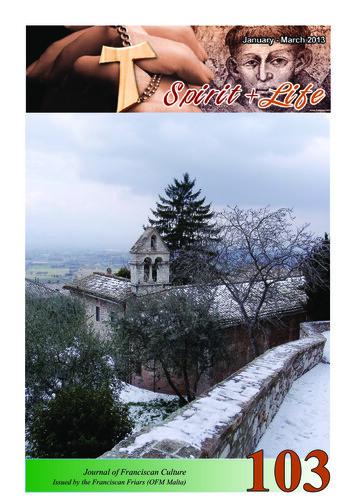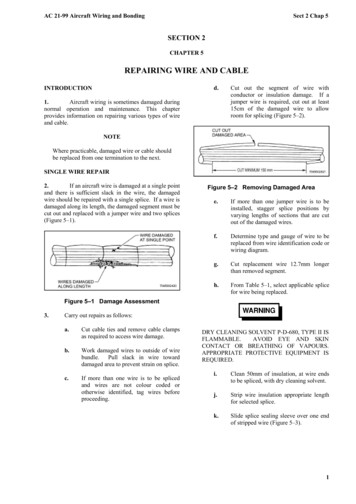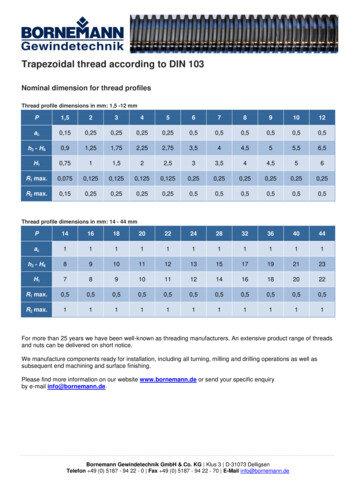
Transcription
Journal of Franciscan CultureIssued by the Franciscan Friars (OFM Malta)103
EditorialEDITORIALMIDDLE EASTcauldronQuarterly journal ofFranciscan culture publishedsince April 1986.Layout:John Abela ofmComputer Setting:Raymond Camilleri ofmAvailable at:http://www.i-tau.comAll original material isCopyright TAU FranciscanCommunications 2013Contents Editorial. 2 The meetings of St. Franciswith the leper. 3 Francis, the Brothers and theanguish of solitude. 14 Joseph of Nazareth in Franciscan Spirituality. 21 Quote. 251032When the Arab spring began two years ago everybody wasthinking that the Middle East would be transformed into a paradise.The lessons of Afghanistan and Iraq had seemingly not been learnt. Theidea that a western type of democracy can flourish in the Middle East ispure imagination. Yet people continue to think that this is the solution toproblems facing people in the Middle East, an openness to democraticinstitutions, pluralism of ideas, religious tolerance. Nothing could befurther from the truth.The Middle East can never be democratic in this way. It hasnever been. The reasons are many and varied. They range from ethnicquestions, to cultural identity, to religious fundamentalism. Maybe onecan understand the Middle East if one is aware of the political, socialand religious framework of Europe in the early Middle Ages. It is apity that many have forgotten the lessons of history and the long wayforward that Europe has accomplished on the road to political, culturaland religious pluralism.The true reason why the Middle East has become a cauldronlies with the intransigent expectations of the western world, which hasrejected its own values and thinks that it can impose its pseudo-valueson others. It is a world that rejects its Christian identity that has shapedits culture and traditions for centuries. It calls religion in society atheocracy. It is seemingly unaware that elements of theocracy whichare not Christian have crept into its political and social framework, andthat the confusion that has followed upon the Arab spring will soonmake itself felt at home.The western world should ask Christians living in Syria,Iraq, Egypt, Libya, and other countries of the region what it meansto enjoy tolerance, freedom of expression and of religious worship.Or rather, what it meant under regimes that the west considered brutaldictatorships, and what it means now under a tribal anarchy whichbreeds violent fanatics adherents of the main religion of the region. Askthe Franciscan friars living in Libya or in Syria, whose suffering is keptlow-key for fear that it might spark retaliation against Christians in theregion. Ask the Trappist martyrs in Algeria. Ask the common Christianswho have lived for centuries in relative peace and harmony with theother main religions in the region, and who are now pushed to leave thevery cradle of Christianity.Politicians have said that, through security, the world hasbecome a safer place to live in. They might convince through rhetoricand airport security that has become an unbearable nightmare. They canisolate a democratic paradise from its evil neighbours by building wallsand fences and creating a state-of-the-art security umbrella againstmissiles, which incidentally has shown its flaws as well. They willnever convince intelligent persons that they have the solution to theboiling problems in the vast region stretching from the western Saharato the Hindu Kush. These problems are bound to spill over well beyondthe oceans and continental masses.Maybe they should ask the Franciscans who have livedin these regions for 800 years how they managed to thrive amongreligious fanatics. They will be surprised to find out that the systemsof government they think are the solution of today’s problems are asoutmoded as the ones they have planned to democratically overthrow.Fr. Noel Muscat ofmSPIRIT LIFE - January - March 2013
Franciscan CultureTHE MEETING OFSAINT FRANCISWITH THE LEPERNoel Muscat ofmThe first encounter I had with the figure ofSaint Francis was when, as an adolescent, I readMichael de la Bedoyere, Francis: A Biographyof the Saint of Assisi, (Harper and Row), NewYork 1962. The author starts the biography ofSaint Francis with the episode of the meeting ofthe leper in the Umbrian plain below Assisi. Thefollowing is the vivid description of this event bythis author.Michael de la Bedoyere’s account“I had rather commit thirty mortal sins thancontract leprosy,” the pious de Joinville (Frenchchronicler c. 1224-1317) said to Saint Louis, Kingof France (1226-1270). He could hardly have putit more strongly, for he was saying that he wouldprefer to take his chance of burning in Hell for alleternity – and in the Middle Ages, men took thefire of Hell very literally – than be touched by theloathsome disease that was the terror of the times.Housed in the lazarettos dotted all overEurope, these miserable relics of men could onlywalk abroad dressed in a long tunic, their handsgloved, and holding a clicker or rattle perpetuallywarning the passerby to keep his distance.Forbidden to talk to others, the leper had to placehimself to the windward when someone wished totalk to him. The Church Herself, despite Her greatwork for the sick, could only pray for the leper’ssalvation in a world beyond the miseries of this one.The leper, dire symbol of sin, was excluded fromthe pity for the downtrodden and the suffering,sympathy for whom was part of the medievalideal of chivalry then in the ascendant. The leper’ssingle hope once his leprosy had been noted andreported was the Lazar’s hope, for the Church saw2013 January - March - SPIRIT LIFEin the parable of Lazarus “covered with sores” whowas “carried to Heaven by the angels” the spiritualsymbol of the leper (Luke 16:19-31). Hence, whenthe bells rang to announce the banning of a leper,people came, silently and morbidly curious towatch, as the touching ceremony which cut theleper off from sound mankind was ready to begin.“My brother, God’s dear poverello,” saidthe priest, vested in cassock and cotta, “throughsadness and tribulation, through illness, desolation,leprosy, and so many earthly miseries lies theroad to the heavenly kingdom where misery andinfirmity are no more, where all are pure and clean,without shadow of beastliness, more resplendentthan the sun My brother, this separation onlytouches your body, for in your spirit, which is somuch more important, you may still be one withus. Keep hidden, and be patient. God be with you.”Then the priest, taking a handful of black earthfrom the cemetery, scattered it over the leper’shead, saying, “Die to the world, and be born againto God.”This rite, while giving consolation andsupreme hope to the spirit, could not alter the gradualthickening of the skin, the lumpy excrescences,the open sores, the falling away of the eyebrows,the grotesque enlarging of the ears and nose, theeventual dropping off of the fingers and toes, andthe fetid smell. It was a man condemned to be adiseased deformity who walked away from theChurch and the world to be born again of sufferingand isolation.“Click, click, click.” The sound drovehealthy people to one side of the road as they heldtheir noses and looked the other way. It was a soundonly too familiar to the men, women, and childrenof thirteenth-century Assisi as they trudged theirway down the steep, dusty slopes from their littlefortress city through the thick woods on to the great3
Franciscan CultureUmbrian plain, once floor of a vast lake. There,sealed within the delicate green of the great valleyand its vast amphitheatre of rosy hills and bluemountain ranges – the “Galilee of Italy,” as Renanwas one day to call it – stood Assisi’s ospidale,San Lazzaro dell’Arce, the town’s lazaretto. Itwas not so very far distant, as it happened, froma desolate little rectangular chapel, destined oneday to become a flaming basilica in the gold ofthe setting sun. Within range of this hospice ofliving death, the good countrymen would be onthe lookout for the lepers, the kindlier among themmurmuring a prayer, the rougher a curse, but allintent, if possible, on avoiding the miselli, themiserable ones.All except one: a young man in his middletwenties. A young man who was then far indeedfrom dreaming, dreamer though he was, that hislife would be commemorated in the golden framehousing that little chapel which would in years tocome catch the eye of numberless visitors as of anevening they looked down over the town acrossthe great valley.His clothes, rather than his face, caught theeye as he rode that day: He had neither the timenor the inclination to look around him, but anyonecould tell that only the best quality and dye in thecloth, only the most fashionable cut in cloak andhose, were good enough for him.Courteously, the rider would smile backa greeting from a passerby, and with a speciallove and tenderness, he would lean over to givea coin to a passing beggar; but his smile wasnow an inner smile, his charity almost a ritual, asthough a distant habitual reflection of the laughterand the glad largesse of the person whom all thepeople of Assisi knew as the born leader of thefashionable younger set of the town. Even thoughhis clothes were the best a man could buy, theywere unusually sober and hardly warm enoughfor this time of the year. He had, in fact, hastilyput them on that morning with hardly a thoughtfor personal comfort. His large eyes, “blackand candid,” had an apprehensive and almostfrightened look, and those who recognized himmay have wondered once again how it had comeabout that this “beau-laid,” less than average inheight, slender and delicate in build, with his thin,unmanly beard, had ever gained ascendancy overthe swaggering young toughs and bullies of a townof very doubtful moral reputation.“Click, click, click.” The dreaded sound4could now be heard in an empty countryside andit was growing louder. It filled the rider with afascinated dread, for he alone of those who passedby that day was being driven toward it by an innercompulsion.It was not by any means the first time thatthis compulsion had led him near the lazaretto. Hehad long been haunted by the despair and miserythat lay behind those thick stone walls, yet unable,prodigal as he had been to the beggars and thesick, to feel anything but stark horror when he sawone of those outcasts. Those miselli, ritually cutoff from the fellowship of mankind, were still, hisconscience told him, his brothers – his brothers inChrist our Lord, aching for “the crumbs that fellfrom the rich man’s table” (Luke 16:21). Theywere as much his brothers as the beggars of Assisiand of Rome itself, where he had once changedclothes with a beggar to show his chivalroussympathy with the oppressed. And he was a richman with indulgent parents who had never deniedhim anything he wanted so long as it helped toadvertise his family’s increasing prosperity. But itwas an even deeper compulsion that had broughthim again and again to the spot, and sent himgalloping away as the sight and smell of theserepulsive creatures turned nightmare into hideousand unbearable reality.But at last he had come to realize withabsolute clarity and certainty that to gallop awayfrom the lepers was also to gallop away from hisdeepest self, from that mysterious, unanalyzed,indeed incomprehensible feeling that called himto the greatness – to the sanctity even – which heknew he had it in him to fulfil.Arnaldo Fortini’s accountA professional description of the realityof lepers in the Assisi contado is given to us bythe famous Assisi historian Arnaldo Fortini,Francis of Assisi. A Translation of Nova Vita diSan Francesco by Helen Moak, The CrossroadPublishing Company, 370 Lexington Avenue,New York, NY 10017, 1992, 206-210. Originaledition: Nova Vita di San Francesco, TipografiaPorziuncola, Santa Maria degli Angeli, AssisiEdition 1959.The hospital for the lepers of the communeof Assisi stood near the castle of Arce. As were allthe old leper hospitals, it was dedicated to SaintSPIRIT LIFE - January - March 2013
Franciscan CultureLazarus, the Biblical beggarcovered with sores.Only in the fourteenthcentury, when devotion toSaint Mary Magdalen becamewidespreadthroughtheinfluence of the writers of devoutlauds, was it given the name ofthe woman who suffered fromleprosy of the soul: Mary ofMagdala, who is said to havebeen contaminated by everysexual sin, until she found Jesus,who took her in and cleansed herfrom every stain.The “infected men andwomen of San Lazzaro d’Arce,”as they are called, file in frontof us in a touching thirteenthcentury document preservedin the Sacro Convento. Thewomen have lovely names.They shine in the darkness of thelazaretto like the traces of beautyremaining on their ravaged facesand infected bodies: DominaMaria, Domina Bona, DominaLatuzaSugulla,DominaStefania, Gilia, Rosa. Theyhave put aside their fine clotheswoven of purple and have put onthe grey tunic and mantle of thehospital. Their faces are as whiteas those of corpses, yet they stillburn with all the desires of which life is cheatingthem.A chaplain is assigned to the hospital bythe city. The statutes specify that he be a man “ofgood reputation and of mature age,” bone fameet mature aetatis, and that he be given board andlodging and a cloak on All Saints’ Day. EverySunday, after he celebrates Mass, he reminds thelepers that every beauty and every gift of earthare destined to fade away more swiftly than themists of autumn. (His words are useless; in thesewalking dead, slimy thoughts and filthy grudgespreoccupy men and women alike. They are alwayslooking for the chance to avenge themselves foreveryone’s horror and hatred of them.)Francis himself, who was moved by theappeals of the poor and did not hesitate to take offhis rich clothes and give them to an impoverished2013 January - March - SPIRIT LIFESaint Francis meets the leperlord, could not conquer the disgust aroused inhim by that dark house of the dead, even when hedid no more than look at it form above. He neverwent near it if he could avoid it. Sometimes thatwas not possible, for the road on which it stoodwas the shortest route to the family property inSan Pietro della Spina. It was called the Strada diCollemaggio, and also, as we read in the statutes,“the road by which from the city of Assisi one goesto the river Tabito,” that is, to the Ose. It began atthe Moiano gate, went down by the Galletta spring,and through San Masseo to the Strada Francesca,from there it led to the hospital, then turned towardCastelnuovo. After a short stretch, one could turnto the left on the Via Antica, the ancient road thatran from Santa Maria degli Angeli to Foligno, andin a few minutes reach San Pietro della Spina.From the height of the hill, these roads may still be5
Franciscan Cultureseen furrowing the great plain.When he did go by the hospital on horseback andsaw on its doorstep the emaciated faces with pusdripping from them, the hideous eyes, he fearfullyturned his face and held his nose, not able to bearthe horrible stench. He sent alms to the patientsby asking others passing along the road to deliverthem, for he did not dare go close to the place.There is nothing left of the old hospitaltoday but the chapel, with its façade of rough cutstones and a little bell tower rising over it. Thechurch is lonely, the countryside around it is silent.But in the evening, when the bell begins to ringin the darkening air, all comes to life again, realenough to shake the heart. The very walls, bareas in the days of the long-vanished hospital, repeatthe ancient rite.The leper lived hidden until someonereported him. We see him torn away from hishouse, brutally taken off to his new destiny. Thenhe is here, in the church, terrified and embitteredas a wild beast caught in a trap from which there isno escape. He is on his knees in front of the altarfor the sacred rite that will solemnly proclaim hisseparation from human society.It is a rainy evening near the end ofNovember. All the candles are lit. In the shadows,some object can be dimly seen on a table at the sideof the sacristy door. The church is comfortablyfilled with people – devout, curious, pious. Thebell rings. The priest comes out in cotta and stole,preceded by clerics carrying the cross. He goesup the steps of the altar, turns, and with the samegesture he uses at funerals, sprinkles with holywater the one who is about to die to the world.Then he delivers his admonition:“My brother, dear poor little man of goodGod, by means of great sadness and tribulation, ofsickness, of leprosy, and of many other miseries,one gains the kingdom of heaven, where there isno sickness or sorrow, and all is pure and white,without stain, more brilliant than the sun. You willgo there, if it pleases God. In the meantime, be agood Christian, bear with patience this adversity,and God will be merciful to you.”The terrible words fall into a silence asprofound as the silence of a cemetery. The livingcorpse bends still lower to the ground. He seemsto be looking for his grave.“My brother, the separation has to doonly with your body. As for the spirit, which is6more important, you are still, as you were before,a participant in the prayers of our Holy MotherChurch, as if every day you were assisting in theDivine Offices. Charitable men will provide foryour lesser needs, and God will never abandonyou. Take care of yourself and have patience. Godis with you. Amen.”From the hands of the acolyte the celebranttakes a handful of black earth brought from thenearby cemetery; he sprinkles it on the head of thesick man.“Die to the world, be born again in God.O Jesus my Redeemer, who made me of earth andclothed me with a body, make me to rise again inthe new day.”The people respond, “My bones tremble,my soul loses its way. Alleluia. Have mercy on us,O Lord. Keep us from evil.”The Gospel is read. It is the story of the tenlepers, the one that begins: “As Jesus was enteringa village he was met by ten men with leprosy.They stood some way off and called out to him,‘Jesus, Master, take pity on us.’”Then it is time for the inexorableinstructions.“My brother, take this cloak and put it onin sign of humility and never leave here without it.In the name of the Father, the Son, and the HolySpirit.”The tunic, made of gattinello (a poor andcoarse cloth made primarily of cotton with somewool added), is full and long, as the statutesprescribe. Reluctantly the leper puts it on. It isthe ominous uniform that will make everyone hemeets flee from him.“Take this little flask. Put in it whatwill be given you to drink, and under penalty ofdisobedience I forbid you to drink from the rivers,from the springs, from the wells.“Take these gloves. You are forbidden totouch anything that is not yours with your barehands.“If, while walking about, you should meetsomeone who wishes to talk to you, I forbid you toreply before you put yourself against the wind.“You are forbidden to be with any womanwho is not of your family. You are forbidden totouch young people or to offer them anything. Andfrom eating from anything but your own leper’sbowl. And from entering churches or rectories,and from going to fairs, to mills, and to markets.And from walking through narrow streets whereSPIRIT LIFE - January - March 2013
Franciscan Culturethose who meet you cannot avoid you.”At last he is given the wooden clapper, thekind sounded in Holy Week.“Take this tentennella; carry it always withyou. Sound it to warn others of your presence.”A cortège forms as if the body is to beaccompanied to a cemetery, the cross in front, thenthe clerics, the priest, the leper, the faithful. Nighthas fallen. The enclosure reeks of a sad autumnalfever. The tentennella, shaken by the leper, fillsthe air with its dismal, clear sound. The flamesof the candles throw light along the long corridorsand narrow passages, on the high columns. Theprocession seems to be passing through a walledcemetery, amid deathlike odors of dampness ofdecay.The cell is ready. A wooden cross is on thedoor. The ghost enters the cell with his gravedigger.Inside are a low, mean bed, like a bier, a table, achair, an old lamp, a strong box. An attendantholds the newcomer sandals, a camel skin hood,an earthenware pot, a beech wood bowl, a copperjug, a belt, a knife. Everything else the leper ownswill go to this hospital of the commune.Now he is required to make the properresponse:“Here is my perpetual resting place. HereI shall live. This is my vow.”Before the door is a stump for the collectionof alms. First the priest puts an offering there; theother faithful follow his example.Then the cortège, without the leper, who isleft in his seclusion, returns to the church. Againthe chant of the priest rises:“Omnipotent God, who throws down thepride of the ancient enemy through the sufferings ofyour Only Son, give to your servant the necessarystrength to bear with devotion and patience theevil that oppresses him. Amen.”Thomas of Celano’s account ofFrancis’ encounter with the leperAfter quoting entire passages from thesetwo texts, we now examine the original account ofFrancis’ encounter with the leper, coming from thepen of his first biographer, Thomas of Celano, Lifeof Saint Francis 17 (FAED I, 195):“Then the holy lover of profound humilitymoved to the lepers and stayed with them. ForGod’s sake he served all of them with great love.2013 January - March - SPIRIT LIFEHe washed all the filth from them, and evencleaned out the pus of their sores, just as he saidin his Testament: ‘When I was in sin, it seemedtoo bitter for me to see lepers, and the Lord ledme among them and I showed mercy to them.’For he used to say that the sight of lepers was sobitter to him that in the days of his vanity when hesaw their houses even two miles away, he wouldcover his nose with his hands. When he startedthinking of holy and useful matters with the graceand strength of the Most High, while still in theclothes of the world, he met a leper one day. Madestronger than himself, he came up and kissed him.He then began to consider himself less and less,until by the mercy of the Redeemer, he came tocomplete victory over himself.”Celano’s account is the oldest amongthe sources that speak about Francis’ encounterwith the leper. As we shall see in practically allthe sources, the text which influenced all themediaeval biographers of Saint Francis was theautobiographical description given by Francishimself in the very verses of his Testament:“The Lord gave me, Brother Francis, thusto begin to do penance in this way: for when I wasin sin, it seemed too bitter for me to see lepers.And the Lord Himself led me among them and Ishowed mercy to them. And when I left them, whathad seemed bitter to me was turned into sweetnessof soul and body. And afterwards I delayed a littleand left the world” (FAED I, 124).This episode may well be considered as theturning point of Francis’s life. The biographers allpoint out to the fact that Francis experienced aninner sweetness when he confronted the bitternessof embracing a leper. The meeting with the leperis part of the long process of conversion of SaintFrancis, which spans the period 1202-1206, but itis certainly one of the most touching and importantmoments of this process (Pierre Brunette, Francisand his Conversions, Franciscan Press, Quincy1997).Julian of Speyer’s account ofFrancis’ meeting with the leperJulian of Speyer’s Life of Saint Francis,written in Paris in 1234-1235, although dependingheavily upon Thomas of Celano’s Life of SaintFrancis, written in 1228-1229, presents the episodeof Francis’ encounter with the leper in paragraph7
Franciscan CultureThe meeting of Francis with the leper inthe Legend of theThree CompanionsThe Chapel of San Rufino dell’Arce12 (FAED I, 376-377):“After this, humbly holding himselfin low esteem and now not caring that he wasdespised by others, he moved to the lepers. Heserved them devotedly by humbly washing theirsores, not even shrinking from wiping away thepus. Previously, such things were so disgusting tohim that he used to hold his nose, not only whenhe saw lepers themselves nearby, but even theirhomes at a distance. But when he was still wearingsecular clothes, the Lord had visited him with hisgrace, when a certain leper happened to meet him.As usual, he was horrified by the sight, but doingviolence to himself, he conquered himself, andstraightaway went up and kissed him. From thenon, he fervently glowed with contempt of self,and began to wage constant war against himselfuntil it was granted him from above to win perfectvictory over himself. Therefore, as he himself latertestified, he showed mercy to the lepers whom hewas unable even to look at while he was living insin.”8The Legend of the ThreeCompanions11(FAEDII, 74) is one of the mostimportant among the Sources,for the simple reason that itconcentrates in a particularway on the early years ofthe life of Saint Francis, andespecially upon the periodof his conversion. Althoughalso depending on Thomas ofCelano, the narration is fullof vivid details that find solidproof in the same place whereit all happened, as we shallsee later on when we speakabout the chapel of Saint MaryMagdalene, marking the spotof the leper hospital of SanLazzaro dell’Arce.“One day, while he waspraying enthusiastically tothe Lord, he received thisresponse: ‘Francis, everything you loved carnallyand desired to have, you must despise and hate,if you wish to know my will. Because once youbegin doing this, what before seemed delightfuland sweet will be unbearable and bitter; and whatbefore made you shudder will offer you greatsweetness and enormous delight.’He was overjoyed at this and was comfortedby the Lord. One day he was riding his horse nearAssisi, when he met a leper. And, even thoughhe usually shuddered at lepers, he made himselfdismount, and gave him a coin, kissing his hand ashe did so. After he accepted a kiss of peace fromhim, Francis remounted and continued on his way.He then began to consider himself less and less,until, by God’s grace, he came to complete victoryover himself.After a few days, he moved to a hospiceof lepers, taking with him a large sum of money.Calling them all together, as he kissed the handof each, he gave them alms. When he left there,what before had been bitter, that is, to see andSPIRIT LIFE - January - March 2013
Franciscan Culturetouch lepers, was turned into sweetness. For, as hesaid, the sight of lepers was so bitter to him, thathe refused not only to look at them, but even toapproach their dwellings. If he happened to comenear their houses or to see them, even though hewas moved by piety to give them alms throughan intermediary, he always turned away his faceand held his nose. With the help of God’s grace,he became such a servant and friend of the lepers,that, as he testified in his Testament, he stayedamong them and served them with humility.”The account of Francis’ meetingwith the leper in Celano’s MemorialeThomas of Celano develops the theme ofFrancis who meets the leper with references towhat the saint says in his Testament. The episode isfound in The Remembrance of the Desire of a Soul,9 (FAED II, 248-249). It is interesting because itincludes a new detail, namely the reference to thehunchbacked woman and to the devil’s temptationto turn Francis into a disfigured person like herif he insisted on doing penance. The answer onFrancis’ part is strongly evangelical. Francis feelsone with the poor and miserable creatures of theworld, symbolized by this poor woman and by theleper that he encounters.“Under his worldly clothing he wore areligious spirit; leaving public places he soughtplaces of solitude, where he was often instructedby visits of the Holy Spirit. He was drawn away,lured by that remarkable delight that from the verybeginning flowed over him abundantly and neverleft him as long as he lived.As he began to visit hidden placesconducive to prayer, the devil struggled to drivehim away with an evil trick. He made Francisthink of a horribly hunchbacked woman who livedin town and whose looks scared everyone. Thedevil threatened that he would become like her ifhe did not turn back sensibly from what he hadbegun. But, strengthened by the Lord, he rejoicedat a response of healing and grace. ‘Francis,’ Godsaid to him in spirit, ‘you have traded what youloved in a fleshly, empty way for things of thespirit, taking the bitter for the sweet. If you wantto come to know Me, despise yourself. For whenthe order is reversed, the things I say will tastesweet to you even though they seem the opposite.’2013 January - March - SPIRIT LIFEHe was moved to obey immediately the divinecommand, and was led through experience of thetruth of these things.Among all the awful miseries of this worldFrancis had a natural horror of lepers, and one dayas he was riding his horse near Assisi he met a leperon the road. He felt terrified and revolted, but notwanting to transgress God’s command and breakthe sacrament of His word, he dismounted from hishorse and ran to kiss him. As the leper stretched outhis hand, expecting something, he received bothmoney and a kiss. Francis immediately mountedhis horse and although the field was wide open,without any obstructions, when he looked aroundhe could not see the leper anywhere.Filled with joy and wonder at this event,within a few days he deliberately tried to dosomething similar. He made his way to the housesof the lepers and, giving money to each, he alsogave a kiss on the hand and mouth. Thus he tookthe bitter for the sweet and courageously preparedto carry out the rest.”The account of Francis’ meeting with the leper in the LegendaMaiorSaint Bonaventure’s account of Francis’meeting with the leper is based upon the episodedocumented by Celano in the Memoriale, butalso contains a Christological interpretation inthe mysterious apparition of Chris
Saint Francis was when, as an adolescent, I read Michael de la Bedoyere, Francis: A Biography of the Saint of Assisi, (Harper and Row), New York 1962. The author starts the biography of Saint Francis with the episode of the meeting of the leper in the Umbrian plain below Assisi. The followi











